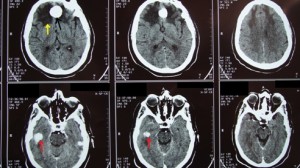Stroke is an acute event – caused by a sudden interruption in the blood flow to the brain – which requires emergency treatment, often followed by long-term treatments that facilitate recovery and  prevent further stroke. The global incidence of stroke has been increasing over the past 25 years, particularly amongst younger people, and this is expected to increase further by 2030 (1). In the UK, there are more than 100,000 strokes each year (2). Stroke is a leading cause of death and disability in the UK (1,2). Advances in the prevention of stroke and its acute treatment and management, for example, improvements in ‘door-to-needle’ time, have reduced overall mortality from stroke in the past 15 years (1). Whilst this is great progress, with more people surviving a stroke, there is a need to understand more about, and find ways to support people to manage the longer-term impact of stroke. The post-acute stroke pathway is very variable with people receiving intermediate or short term rehabilitation when discharged back to the community and then sometimes only for short intervals of time with little or no support thereafter (3).
prevent further stroke. The global incidence of stroke has been increasing over the past 25 years, particularly amongst younger people, and this is expected to increase further by 2030 (1). In the UK, there are more than 100,000 strokes each year (2). Stroke is a leading cause of death and disability in the UK (1,2). Advances in the prevention of stroke and its acute treatment and management, for example, improvements in ‘door-to-needle’ time, have reduced overall mortality from stroke in the past 15 years (1). Whilst this is great progress, with more people surviving a stroke, there is a need to understand more about, and find ways to support people to manage the longer-term impact of stroke. The post-acute stroke pathway is very variable with people receiving intermediate or short term rehabilitation when discharged back to the community and then sometimes only for short intervals of time with little or no support thereafter (3).
The work of improving stroke care relies on research, quality improvement and developing the evidence base. Research needs to address the issues and priorities that are most important to stroke survivors and their families, as well as people delivering stroke care and stroke services. The recent James Lind Alliance Priority Setting Initiative in Stroke established meaningful partnerships between stroke survivors, clinicians and representative groups to identify the top 10 research priorities relating to life after stroke and increasingly these are being used to inform and drive stroke research (4,5).
May is Action on Stroke Month! To mark this, EBN will be publishing a series of blogs throughout the coming week (13th to 17th May) highlighting issues related to the acute and longer-term management of stroke and presenting stroke survivor perspectives on life after stroke and experiences on supporting patient and public involvement in stroke research. Our twitter chat on the 15th May (8-9pm, UK time) will also focus on current practice and challenges in the acute and long-term management of stroke and priorities for future stroke research. We are especially keen to hear all perspectives and hope to engage stroke survivors and their families, practitioners and clinicians, and researchers.
During the chat we will be considering the following questions:
1. What are clinical priorities in the acute management of stroke?
2. What are the clinical priorities in the longer-term management of stroke?
3. How can we involve stroke survivors and their families in a more collaborative way?
4. What are the key priorities for future stroke research?
Join us @EBNursingBMJ and using #ebnjc to share your thoughts.
References:
(1) https://www.gov.uk/government/news/new-figures-show-larger-proportion-of-strokes-in-the-middle-aged
(2) Stroke Association (2018) State of the Nation – Stroke Statistics London Stroke Association https://www.stroke.org.uk/sites/default/files/stroke_association_strategy_2015_to_2018.pdf
(3) Stroke Association (2015) Together we can conquer stroke: Stroke Association Strategy 2015-2018 https://www.stroke.org.uk/sites/default/files/stroke_association_strategy_2015_to_2018.pdf
(4) Pollock A, St George B, Fenton M & Firkins L (2012) Top ten research priorities relating to life after stroke The Lancet Neurology 209 doi: https://doi.org/10.1016/S1474-4422(12)70029-7
(5) Rowat A, Pollock A, St George B, Cowey E, Booth J, Lawrence M, Scottish Stroke Nurses Forum (SSNF) (2016) Top 10 research priorities relating to stroke nursing: a rigourous approach to establish a national nurse-led research agenda Journal of Advanced Nursing 72:22:2831-2843 doi: https://doi.org/10.1111/jan.13048